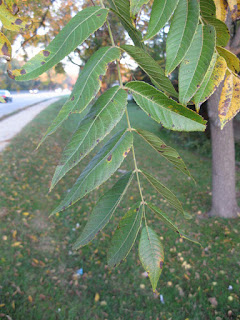 |
| The American black walnut tree |
For anyone with black walnut trees, fall can be summed up in three words – duck and cover.
Sit or stand below one of these trees and you can be bombarded. Sometimes by nuts randomly dropping off the tree, but more often by the squirrels. They nibble at the hulls surrounding the walnuts and then drop them as they skitter away, chattering all the while.
Actually, I think they save up their “leftovers” during the day to use when hapless victims pass underneath. At least it seemed that way when I had two black walnuts in my back yard and a third one that stretched over the fence from one of my neighbors.
 |
| Black walnuts on the ground |
We hadn’t realized that the mature trees in the back yard were black walnuts when we bought the property and built a deck. It took only one party before we threw in the towel on fall entertaining.
The back yard had been quiet all afternoon.When the guests arrived, though, the walnuts rained down on the only person wearing a very white shirt. As anyone who’s been hit by a walnut hull knows, the resulting brown stains don’t come out. Ever.
These black walnuts were majestic trees that must have been about 100 years old. They were late to leaf out in the spring, allowing plenty of time for bulbs to bloom and recharge. They provided great shade in the afternoon which helped keep the house cool.
I also felt somewhat of an obligation to keep them since they were among the last walnuts in theWalnut Grove Rearrangement. There were times when I thought about it, though, given all the problems growing plants under their canopy.
The American black walnut (juglans nigra) emits a chemical with a distinctive smell called juglone. It instantly kills roses and tomatoes. It's also toxic to horses and possibly dogs.
Not all plants die. Many just didn’t thrive. I found several lists of juglone-tolerant plants but ended up more confused than ever. Each list was different.
One list said peonies wouldn’t work but I had a lot of peonies at the base of my tallest walnut tree. In fact, they had grown under a chain link fence from my neighbor’s property. The old-fashioned version of Jacob’s ladder (polemonium) did well, as most lists suggested. A cultivar with variegated leaves died after a month.
My planting style became one of trial and error. I’d buy one plant. If it survived, I bought two more. I learned that wild flowers, leopard’s bane, spiderwort, hostas, astilbes and toad lilies were my friends. In fact, the older the variety and more vigorous it was, the better the plant seemed to do.
 |
| Black walnut leaves |
Don’t count on using your walnut crop as food unless you’re willing to do some major work. The hulls are so caustic that you need solvent-proof gloves to handle them. The shells are hard to crack. It's a lot easier to just buy walnuts at the grocery store.
Whatever you do, don’t call a tree service and ask them to cut down a walnut tree for free. Although walnut is an expensive wood, they will only laugh. They generally need an entire grove to make it worth their while and most urban trees aren't suitable.
Walnuts don’t reliably produce a crop until they are 30 to 50 years old, making them very big and very expensive to take down at that point. Also, some years the walnut crop is very light. We tried, but during the 15 years we lived there, we never were able to determine why some crops were heavier than others.
Even if you cut the tree down, juglone remains in the soil for a long, long time. One of my neighbors, a major rose fancier, unfortunately found this out after moving in and cutting down her walnut tree. All of her roses instantly bit the dust. Their replacements a few years later also died.
In my book, it’s definitely better to learn to live with walnuts. Focus on the other three seasons. Try wildflowers. Whatever you do, don’t give up. Black walnuts can be a tough nut to crack but you can still have a beautiful yard.
By Karen Geisler

2 comments:
Fascinating post about black walnuts. I presume having read about them theses are not the same walnuts that I would buy in the deli?
Most of the walnuts you see in a grocery store or deli are English walnuts raised in California. These are milder and easier to crack than the black walnut. There are companies that process black walnuts, though. Hammons Products of Missouri is one.
Post a Comment